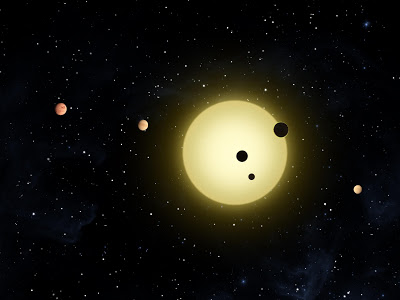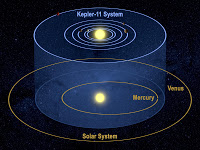Astronomy
The Kepler spacecraft started doing its work in May 2009, continuously watching the stars contained in a patch of sky with the hope of being able to discover exoplanets. Just recently, the Kepler team had a very exciting set of announcements resulting from this diligent work.
One of these was the discovery and confirmation of a newly found planetary system with six confirmed planets. Their star, Kepler-11, is a sun-like star, located about 2000 light years away from Earth. This star is only the second known so far to host multiple planets outside of our solar system, and now holds the record for hosting the most known planets. Plus, all of its planets have extremely tight orbits. The largest orbit is smaller than that of Venus in our solar system, while the other five orbits are even smaller than that of Mercury. This results in the most compact planetary system yet discovered in addition to the largest planetary system by number. Furthermore, the planets are bigger than the Earth, with the largest planet comparable to the size of Uranus and Neptune in our solar system. Still five of the six newfound planets are among the eight smallest extrasolar planets found so far. These interesting facts and characteristics of the system also lead to some clues about the formation and the dynamics of the system.
Kepler detects planets by measuring for drops in the light of their stars as they pass across, called the transit method (This method is detailed further in this previous post about Kepler). Measuring the changes in how much the light drops, at what times, and in what patterns can allow astronomers to calculate characteristics of the planet like size, distance from the star, and number of planets. Since the planets are located extremely close to each other in this particular system, five of the six planets produce significant perturbations on each others orbits that are measurable by Kepler. As they are detected, they will let the researchers calculate estimates for the masses of these planets. Further transits in the future will allow the estimates to be further refined. Adding this information with the sizes of the planets leads to the density of the planets that in turn could allow other researchers to hypothesize about the makeup of the planet. The densities of the planets in the Kepler-11 system appear low, suggesting that they are gaseous planets composed of light elements. These would be similar to planets like Neptune in our solar system rather than terrestrial planets like Earth. The conclusions also give suggestions about the formation of the planetary system. Presence of a large amount of light gas likely means that these planets were formed early in the history of their system. Finding out more about the formation of other planetary systems, such as this one, could, in turn, lead to valuable realizations about our own system.
Yet, probably the more important announcement could be that in addition to these confirmed planets, Kepler has found over 1200 other planet candidates. These are discoveries that result in data that may be similar to that produced by the presence of an exoplanet, but needs to be verified and confirmed. The amount of actual planets from the list will almost definitely be less, but, more importantly, by how much? Some analyses are suggesting that about 80 to 90 percent of the objects on this preliminary list could be planets. This means that the amount of exoplanets discovered (currently about 530) could go up very significantly, by around 1000 (or about 200% of the current number) if the early analyses end up being accurate. Plus, in that preliminary list of planets, 54 are located in the habitable zone of their stars. This zone includes the orbits where a planet could potentially hold liquid water. The radius of one of these is about 0.9 times the size of the Earth?s, while the radii of four others are less than two Earth radii. A planet more Earth-like than any discovered so far may be among these data.
Results like this one are hugely important. They suggest the presence of the hundreds of other star systems, some unique systems like Kepler-11, or perhaps others also like our own solar system.
- A Large Planet Orbiting A Small Star
An artist's conception of the planetary system. Astrometry, a 50 year old technique used to find exoplanets, planets around other stars, has finally succeeded. Planets outside the solar system are nearly impossible to see, so the method relies on...
- Kepler: Finding Earth-size And Smaller Extrasolar Planets
Tonight, March 6, a Delta II rocket lifted off from the launch pad at NASA's Cape Canaveral Air Force Station in Florida, United States. Onboard is a very special payload, Kepler. Kepler's mission is to try to reach the ages old goal of trying...
- Planets Like Binary Stars, Too
In our solar system, planets, comets, asteroids, and dwarf-planets all orbit around a single star, our Sun. But imagine if we could witness two Suns in our sky. NASA's Spitzer Space Telescope has helped astronomers see that planetary systems are...
- Nasa's Kepler Spacecraft Discovers Eight New Earth-like Planets
The search for Earth-like planets has moved a step further. Astronomers have discovered eight new planets orbiting in the habitable zone called ?Goldilocks zone? of their host stars. The discovery of the eight new planets has been made by astronomers...
- Solar System
Solar System Facts The Solar System formed around 4.6 billion years ago. There are eight planets in the Solar System. The four inner planets are Mercury, Venus, Earth and Mars while the four outer planets are Jupiter, Saturn, Uranus and Neptune.For...
Astronomy
Kepler Discovers New Planetary System and Announces Over 1200 Planet Candidates
The Kepler spacecraft started doing its work in May 2009, continuously watching the stars contained in a patch of sky with the hope of being able to discover exoplanets. Just recently, the Kepler team had a very exciting set of announcements resulting from this diligent work.
 |
| An artist?s conception of the Kepler-11 system. Image: NASA/Tim Pyle |
 |
| Comparison of Kepler-11 orbit sizes and our Solar System?s orbit sizes. Image: NASA/Tim Pyle |
Kepler detects planets by measuring for drops in the light of their stars as they pass across, called the transit method (This method is detailed further in this previous post about Kepler). Measuring the changes in how much the light drops, at what times, and in what patterns can allow astronomers to calculate characteristics of the planet like size, distance from the star, and number of planets. Since the planets are located extremely close to each other in this particular system, five of the six planets produce significant perturbations on each others orbits that are measurable by Kepler. As they are detected, they will let the researchers calculate estimates for the masses of these planets. Further transits in the future will allow the estimates to be further refined. Adding this information with the sizes of the planets leads to the density of the planets that in turn could allow other researchers to hypothesize about the makeup of the planet. The densities of the planets in the Kepler-11 system appear low, suggesting that they are gaseous planets composed of light elements. These would be similar to planets like Neptune in our solar system rather than terrestrial planets like Earth. The conclusions also give suggestions about the formation of the planetary system. Presence of a large amount of light gas likely means that these planets were formed early in the history of their system. Finding out more about the formation of other planetary systems, such as this one, could, in turn, lead to valuable realizations about our own system.
 |
| Locations of Planet Candidates in Kepler FOV Image: NASA/Wendy Stenzel |
Results like this one are hugely important. They suggest the presence of the hundreds of other star systems, some unique systems like Kepler-11, or perhaps others also like our own solar system.
- A Large Planet Orbiting A Small Star
An artist's conception of the planetary system. Astrometry, a 50 year old technique used to find exoplanets, planets around other stars, has finally succeeded. Planets outside the solar system are nearly impossible to see, so the method relies on...
- Kepler: Finding Earth-size And Smaller Extrasolar Planets
Tonight, March 6, a Delta II rocket lifted off from the launch pad at NASA's Cape Canaveral Air Force Station in Florida, United States. Onboard is a very special payload, Kepler. Kepler's mission is to try to reach the ages old goal of trying...
- Planets Like Binary Stars, Too
In our solar system, planets, comets, asteroids, and dwarf-planets all orbit around a single star, our Sun. But imagine if we could witness two Suns in our sky. NASA's Spitzer Space Telescope has helped astronomers see that planetary systems are...
- Nasa's Kepler Spacecraft Discovers Eight New Earth-like Planets
The search for Earth-like planets has moved a step further. Astronomers have discovered eight new planets orbiting in the habitable zone called ?Goldilocks zone? of their host stars. The discovery of the eight new planets has been made by astronomers...
- Solar System
Solar System Facts The Solar System formed around 4.6 billion years ago. There are eight planets in the Solar System. The four inner planets are Mercury, Venus, Earth and Mars while the four outer planets are Jupiter, Saturn, Uranus and Neptune.For...
